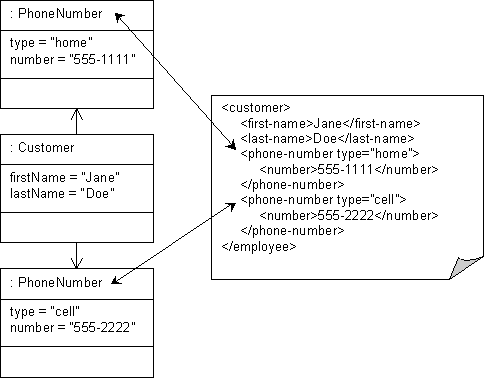Notice: this Wiki will be going read only early in 2024 and edits will no longer be possible. Please see: https://gitlab.eclipse.org/eclipsefdn/helpdesk/-/wikis/Wiki-shutdown-plan for the plan.
Difference between revisions of "EclipseLink/UserGuide/MOXy/Relationships/Privately Owned/One-to-Many"
< EclipseLink | UserGuide | MOXy | Relationships | Privately Owned
| Line 37: | Line 37: | ||
[[Image:Ccxm.gif|XML Composite Collection Mapping]]<br><br> | [[Image:Ccxm.gif|XML Composite Collection Mapping]]<br><br> | ||
| − | The following example shows how to annotate your Java class to obtain this mapping with EclipseLink. The standard JAXB '''@XmlElement''' annotation | + | The following example shows how to annotate your Java class to obtain this mapping with EclipseLink. The standard JAXB '''@XmlElement''' annotation, when used on a '''Collection''' field, can achieve this. |
<source lang="java"> | <source lang="java"> | ||
Revision as of 16:06, 10 March 2011
| EclipseLink | |
| Website | |
| Download | |
| Community | |
| Mailing List • Forums • IRC • mattermost | |
| Issues | |
| Open • Help Wanted • Bug Day | |
| Contribute | |
| Browse Source |
One-to-Many Mapping
This section illustrates how to map one-to-many relationships with Eclipselink.
The schema below shows a typical 1:M relationship between Customer and PhoneNumber
<?xml version="1.0" encoding="UTF-8"?> <xsd:schema xmlns:xsd="http://www.w3.org/2001/XMLSchema"> <xsd:element name="customer" type="customer-type"/> <xsd:complexType name="customer-type"> <xsd:sequence> <xsd:element name="first-name" type="xsd:string"/> <xsd:element name="last-name" type="xsd:string"/> <xsd:element name="phone-number" type="phone-type" minOccurs="0" maxOccurs="unbounded"/> </xsd:sequence> </xsd:complexType> <xsd:complexType name="phone-type"> <xsd:sequence> <xsd:attribute name="type" type="xsd:string"/> <xsd:element name="number" type="xsd:int"/> </xsd:sequence> </xsd:complexType> </xsd:schema>
The following example shows how to annotate your Java class to obtain this mapping with EclipseLink. The standard JAXB @XmlElement annotation, when used on a Collection field, can achieve this.
@XmlRootElement @XmlAccessorType(XmlAccessType.FIELD) public class Customer { @XmlElement(name="first-name") private String firstName; @XmlElement(name="last-name") private String lastName; @XmlElement(name="phone-number") private List<PhoneNumber> phoneNumbers; ... } @XmlAccessorType(XmlAccessType.FIELD) public class PhoneNumber { private String type; private Integer number; ... }
The following example shows how to define your mapping information in EclipseLink's OXM metadata format.
... <java-type name="Customer"> <xml-root-element name="customer"/> <java-attributes> <xml-element java-attribute="firstName" name="phone-number" type="java.lang.String"/> <xml-element java-attribute="lastName" name="phone-number" type="java.lang.String"/> <xml-element java-attribute="phoneNumbers" name="phone-number" type="PhoneNumber"/> </java-attributes> </java-type> <java-type name="PhoneNumber"> <java-attributes> <xml-attribute java-attribute="type" type="java.lang.String"/> <xml-value java-attribute="number" type="java.lang.Integer"/> </java-attributes> </java-type> ...

